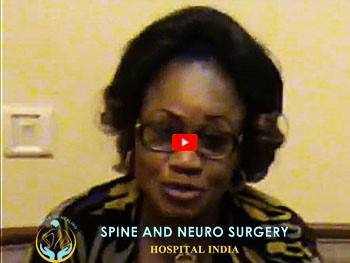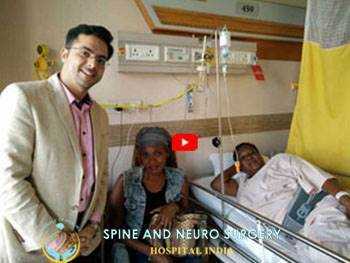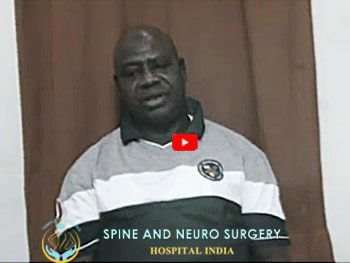Lumbar Radiculopathy - Consult about the Disorder!
Lumbar Radiculopathy Overview:

Lumbar radiculopathy refers to the irritation of nerves caused by damage to the discs present between the vertebrae. This condition occurs in nearly 3-5% of the population. Often men in their 40s and women between the age range of 50-60 are affected with lumbar radiculopathy. Often 10-25% symptoms persists for more than six weeks in people suffering from this condition. Let us learn more facts about this disorder for free consultation.
Lumbar Radiculopathy Causes and Diagnosis:
Causes:
Many disease states can cause this condition, however, the most usual causes include a structural problem like a bone spur, herniated disc, traumatic event or mechanical stretching. The discs may also be damaged due to a congenital defect, strenuous activity or a traumatic event. When the disc is damaged, then the materials in the discs start leaking and this will result in squeezing the nerve root. This condition will cause tingling, numbness, weakness and pain.
The irritation of the nerves can be caused due to the mechanical compression of the nerve. Other rare causes for mechanical compression of the nerve include infection or tumor. Both tumors or infection can reduce the amount of space in the spinal canal and compress the exit nerve. Other causes of lumbar radiculopathy include diabetes, degeneration or inflammation from trauma.

Planning your medical trip to India is a very simple process with Spine and Neuro Surgery Hospital India
- You just need to fill in our enquiry form and one of our executive will contact you soon.
- +91-9325887033 Call us at the given to contact number for any assistance.
- Complete information regarding surgery is provided on our website.
Check out the Patient Testimonial, where the patient shares about their success stories from treatments through Spine and Neuro Surgery Hospital India
Diagnosis:
The physician will start the diagnosis of lumbar radiculopathy with a physical examination and medical history of the patient. The doctor will ask you about the type of symptoms, location and duration so that he/she can localize the nerve that is responsible for your condition. The doctor will check muscle strength, reflexes and sensation to determine any abnormalities. The patient will be asked to obtain imaging studies. X-rays are often obtained first. An MRI scan will be obtained to look at the soft tissues around the spine, including the disc, nerves and the ligaments. If the patient is unable to undergo an MRI scan, then he/she may be asked to obtain a CT scan.
In certain cases, your doctor will order a nerve conduction study or EMG (electromyogram) to determine any damage to the nerve.
Lumbar Radiculopathy and associated diseases:

Low back pain and leg pain are associated with the lumbar radiculopathy. Approximately 80% of the world’s population is plagued with back pain or leg pain at one time or the other. Associated leg pain also called as lumbar radiculopathy occurs less frequently but the pain can be debilitating and bothersome. This condition can limit your daily activities. However, the leg pain and back pain can be resultant of a variety of reasons other than causes originating in your spine.
Lumbar Radiculopathy Symptoms and Treatment:
Symptoms:
The symptoms depend upon the affected nerves that exit from the neck (cervical spine). The most common symptoms of lumbar radiculopathy are numbness, pain and tingling in the arms or legs. Patients also complain about the localized neck pain and back pain. Often the pain caused due to this condition radiates from a lower extremity and called as sciatica. Some patients develop hypersensitivity to light touch as it feels quite painful in the affected area. In rare cases, patients can develop weakness in the muscles which are controlled by the affected nerves, thereby indicates the nerve damage.
Treatment:
The treatment for lumbar radiculopathy in india ranges from medical management to surgery. Medical management refers to educating the patient, prescribing medications to relieve pain and muscle spasms, physical therapy (massage, heat, electrical stimulation, ultrasound), cortisone injection or epidural injection around the spinal cord and rest to avoid re-injury.
If the medical management for treating lumbar radiculopathy then surgery is needed. Patients having unrelenting pain, incontinence indicating spinal cord irritation, severe impairment of the function will be referred by the surgeons to undergo surgery. The surgery performed depends upon the overall health and age of the patient. The goal of the surgery is to remove the compression of the affected nerve. Considering the cause of the condition, either laminectomy or discectomy will be performed.
- A laminectomy is a procedure to remove a small portion of the bone that covers the nerve to allow it an additional space.
- A discectomy is a surgical procedure to remove the portion of the disc that has herniated out and is compressing the nerve.
If a large lumbar radiculopathy causes severe damage to the nerves along with acute bowel or bladder incontinence or paralysis, then emergency surgery is required.
The surgery for lumbar radiculopathy is performed by expert surgeons in India. Spine and Neuro Surgery Hospital in India offers the best medical treatment and care for patients suffering from this condition.
- 1800 INTERNATIONAL PATIENTS OPERATED IN LAST 10 YEARS
- PATIENT SATISFACTION RATIO OF OUR PATIENTS IS 97%
- OUR CONSULTANTS WILL BE VISITING MALAWI, KENYA AND ZIMBABWE THIS YEAR FOR CLINICS
- WE HAVEPARTNERED WITH HOSPITALS IN THE MIDDLE EAST FOR SECOND OPINIONS WITH OUR SURGEONS IN INDIA
- 9 OF OUR SURGEONS DECORATEDWITH HONORS/ AWARDS FOR THEIR DEDICATED SURGERY PRACTICES
Get Low Cost Lumbar Radiculopathy Treatment in India
We offer free assistance to international patients to find best medical treatment in India. We offer low-cost, world-class medical treatment in India, coordinated by a team of experienced service industry professionals
Please post a query to know about low cost treatment options at top India hospitals
Click Here



